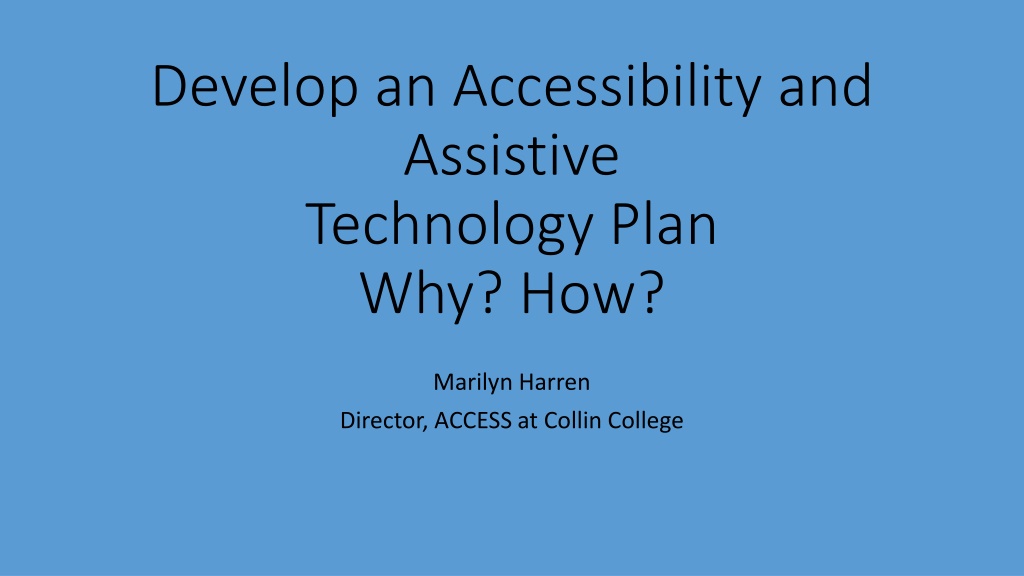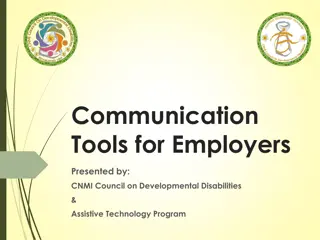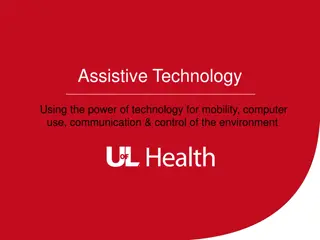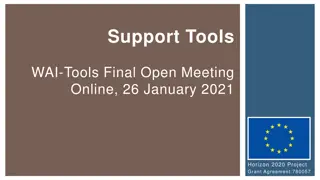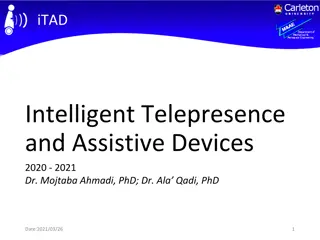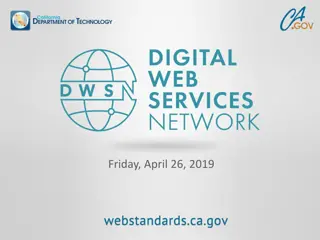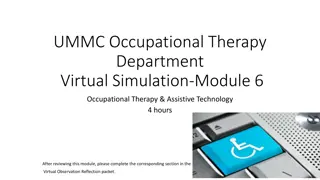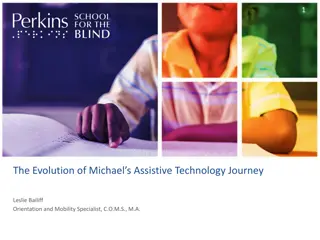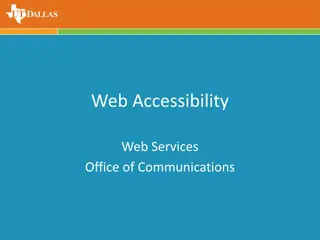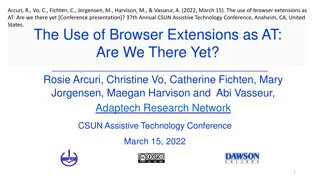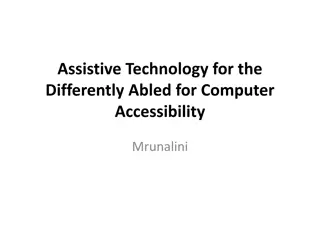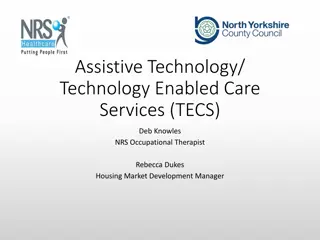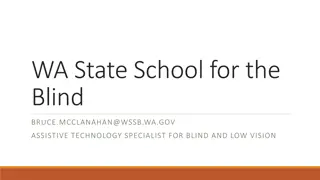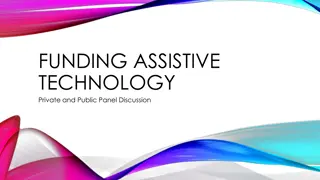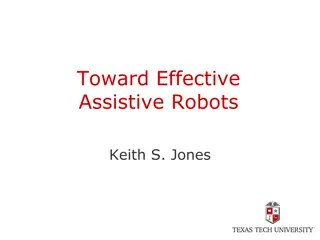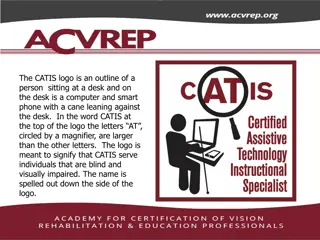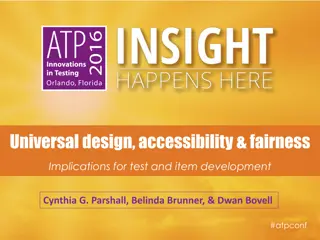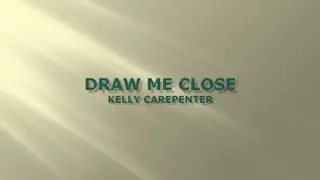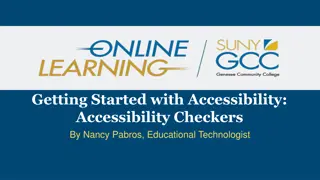Developing an Accessibility and Assistive Technology Plan for Educational Institutions
Developing an Accessibility and Assistive Technology Plan is essential for educational institutions to comply with regulations such as ADAAA, Title II, Section 504, and Section 508. This plan aids in providing equal access to students with disabilities, ensuring compliance with federal standards and guidelines. The plan includes reaching out to instructors, providing alternate media formats, and utilizing assistive technology to support students with vision or hearing impairments. By implementing such a plan, colleges can enhance student progress, save time, and promote inclusivity in their educational environment.
Download Presentation

Please find below an Image/Link to download the presentation.
The content on the website is provided AS IS for your information and personal use only. It may not be sold, licensed, or shared on other websites without obtaining consent from the author. Download presentation by click this link. If you encounter any issues during the download, it is possible that the publisher has removed the file from their server.
E N D
Presentation Transcript
Develop an Accessibility and Assistive Technology Plan Why? How? Marilyn Harren Director, ACCESS at Collin College
Can a good assistive technology plan assist your students to make progress and save you time? YES eventually!
Why? ADAAA, Title II (Title III applies to civil rights of people with disabilities in the private sector. Entities must make themselves accessible when they can afford to do so.) Section 504 and Section 508
Why? Under Section 508 Section 508 covers: Access to federal programs and services in regards to electronic and information technology. If your college receives federal financial aid, this is required. Section 508 requires that alternative, accessible information technology which can be operated in a variety of ways and does not rely on the ability of the user, is required to be provided to those with disabilities. This includes the student, the public, your alumni, and those accessing your web content. Source: Leslie, 2018, Section 508, Applicability & Conformance Requirements|Section508.gov.
Why? Section 508 (continued) The U.S. Access Board published updated Section 508 standards. This updates and clarifies the Access Board's "standards for electronic and information technology developed, procured, maintained, or used by Federal agencies covered by Section 508 of the Rehabilitation Act of 1973 . Compliance was required January 18th, 2018 Source: Section 508 and EIT standards.
Dudley Consent Decree (Summary of Best Practice) When students with vision or hearing impairments who are registered with a disability office, the consent decree suggest that the disability office reach out to each instructor twice during the semester and the student once a month, to assure that alternate media needs are addressed and identify all materials in a classroom or lab determining what format the student prefers and confirm with the student that the format is usable. Decree covers and is not limited to students, prospective students, applicants, accepted but not yet attending students, and alumni. Oh yes any student served by the disability office using alternate media/assistive technology can request this level of support. Source: Consent Decree Aleeha Dudley v. Miami 2015 case of Dudley v. Miami University Case No. 1:14-cv-38 (consent-compromise in lieu of litigation & history of hearing about this case)
Assistive Technology Plan After hearing about Dudley and understanding that 508 was updated effective January 2018, concern set in!
What is assistive technology? Any item, piece of equipment, or product, whether acquired commercially, off the shelf, modified, or customized, that is used to increase, maintain, or improve the functional capabilities of individuals with disabilities. Simply stated, assistive technology are tools and resources used by individuals with disabilities to help improve their quality of life and increase their independence . Source: Assistive Technology Definition, Harner, 2019
How Timely? Timeliness From the Department of Justice Part 35.160: In order to be effective, auxiliary aids and services must be provided in accessible formats, in a timely manner, and in such a way as to protect the privacy and independence of the individual with a disability .
More on Timeliness Resolution Agreement- University of Phoenix .Adherence to these accessible technology standards is one way to ensure compliance with the University s underlying legal obligations to ensure applicants, students, and members of the public are able to independently acquire the same information, engage in the same interactions, and enjoy the same benefits and services within the same timeframe as their nondisabled peers, with substantially equivalent ease of use; and that they are not excluded from participation in, denied the benefits of, or otherwise subjected to discrimination in any University programs, services, and activities delivered online . Source: Resolution Agreement-University of Phoenix 2015 (case number 08-15-2040 )
Low and High Tech Low Tech Sticky notes Is there an app for that? Screen colored overlays Colored transparencies Pencil grips Fidget toys Digital recorder Tracking ball High Tech JAWS/NVDA (free) Juliet Braille Embosser CCTV CART and Typewell Dragon Naturally Speaking Kurzweil, Read&Write, Wynn Wizard Portable document cameras Assistive listening devices
Free and low-cost Assistive Technology Georgia Tech App Finder: https://gatfl.gatech.edu/favorite-search.php Augsburg University Free or low cost technology for everyone: https://www.augsburg.edu/class/groves/assistive-technology/everyone/ Notability-note taking app Voice Dream Reader Be my eyes-low vision or blind
Free and low-cost Assistive Technology #2 Seeing AI-for low vision or blind student One Note- note taking app Google Voice Typing-speech to text option Lane Community College Accessible Technology: https://www.lanecc.edu/it/helpdesk/assistive-technology
Developing A Plan Borrow and steal (give credit where it is due) Do not reinvent the wheel. There is no perfect model out there. Analyze and adjust as needed.
SETT Student/Skills Environment Tasks Tools This framework creates a user focused assessment. Source: SETT framework designed by Joy Zabala
Assistive Technology Assessment-Where to start? AT Assessment Student Questionnaire Do you have a computer, tablet or smart phone? What kind? What (if any) experience do you have with computers/software? ___Little to no experience using a computer ___Able to navigate the internet using a web browser ___Can use word processing software like Microsoft Word, Google Docs, etc. ___Can send and receive emails via multiple email clients ___Can transfer files from a flash drive ___Can download a program to a computer Other_________________________________________________________________________
Student Questionnaire (2) What (if any) experience do you have with assistive technology? ___Unfamiliar with assistive technology ___Use audio recording applications and/or software-what kind? ___Use note taking applications and/or software-what kind? ___Use screen reading applications and/or software-what kind? ___Use speech recognition applications and/or software-what kind? ___Use text-to-speech applications and/or software-what kind? ___Use magnification applications and/or software-what kind? ___Use magnification hardware (CCTVs, mobile cameras, etc.)-what kind? Other________________________________________________________________________
Student Questionnaire (3) What task(s) at school is most challenging for you? ___Computer input ___Mathematics ___Note Taking ___Reading ___Writing Other________________________________________________________ What questions do you have? Source: Bromley 2016
Identified Strengths and Barriers Accommodation Specialist Report Post-Intake Reading Comprehension Executive Functioning Writing Expression Following Instructions Speaking/Expression Math Problem Solving Listening Comprehension Working Memory Visual-Spatial Mobility Math Calculation Vision Organizing/Evaluating Information Processing Speed Pertinent information from this report will be summarized on the AT Assessment Tool to help guide the decision-making process.
AT ASSESSMENT Date:______________ Student: ________________________________ Task to be assessed: __________________________________________________________ With the right tools and/or training the student will be able to:________________________ ___________________________________________________________________________ ___________________________________________________________________________ From Summary of Accommodation Specialist Report Post-Interview Student s strengths: __________________________________________________________ Barrier(s) at time of assessment: ________________________________________________ ___________________________________________________________________________________
AT Assessment (2) AT device(s) recommended? Yes _______________ No ___________ If yes, what?____________________________________________________________________ ______________________________________________________________________________ Training- By whom: ________________________________ How often: ____________________ Days and time for training:_____________________________________________________ Week 1- report on use of AT:____________________________________________________ Will student continue with current AT? Yes ___________ No___________ If no, what needs to be addressed? ____________________________________________________________________________
AT Assessment (3) If yes, Week 2 report on use of AT: _____________________________________ Will student continue with current AT? Yes No If no, what needs to be addressed?__________________________________________________________ If yes, Week 3- Is the AT meeting the student s needs? Yes No If no, reassess student s need and barriers to address with different AT device: __________________________________________________________________________ __________________________________________________________________________
Accessibility Plan Disability Services Offices will meet with every student with a vision or hearing impairment and offer to meet with every student who requires assistive technologies or curricular materials in alternate formats, and their instructors, to develop an accessibility plan. THIS STUDENT S INFORMATION MUST BE KEPT STRICTLY CONFIDENTIAL Name:___________________________ ID#__________________ Email: _______________________________________________ Phone: ______________________ Semester/Term: ___________________ Program of study: ______________________________________
Accessibility Plan (2) Preferred formats (PDF, Word, Braille, EPub, other?): ___________________________________________________________ Need for communication access/type? (ASL Interpreter, CART, Typewell, captioned media, audio description) ___________________________________________________________ What current Assistive Technology do you use?: ___________________________________________________________ ___________________________________________________________ Attach student s current schedule
Accessibility Plan (3) Additional information that will aid in the implementation of the classroom accommodations: ______________________________________________________ _____________________________________________________________________ _____________________________________________________________________
Accessibility Plan (4) Instructor/Faculty Contact Form Instructors Name/Class Date Date Date Date Date Date Date
Student Contact Please date and initial for each meeting with ________________________________ (student name) September October November December January February March April May June July August Comments
Quality Indicators for Assistive Technology QIAT has a post-secondary questionnaire to use as an internal evaluation/institutional self-study of AT on your campus. Campus Self-Evaluation Matrix QIAT-PS is a set of quality indicators in five content areas for Assistive Technology (AT) in Post-Secondary education. Evaluate to improve AT services at your school. Check out the Campus Self-Evaluation Matrix. http://qiat-ps.org/
QIAT Assistive Technology Assessment Process Planner (Sample of what is used in some pre-K-12th) Referral for AT assessment is made by any member of the team when classroom strategies and tools do not meet the student s needs. AT assessments in pre-k-12th are completed by a collaborative team sharing responsibilities. Very detailed with expected outcomes and how those will be measured. Source of information for QIAT: www.qiat.org
Resources: 28 CFR 35.160 - General. (n.d.). Retrieved May 13, 2019, from LII / Legal Information Institute website: https://www.law.cornell.edu/cfr/text/28/35.160 Applicability & Conformance Requirements | Section508.gov. (n.d.). Retrieved October 1, 2018, from https://www.section508.gov/create/applicability-conformance Consent Decree: Aleeha Dudley and the United States v. Miami University, et al. (n.d.). Retrieved September 15, 2018, from https://www.ada.gov/miami_university_cd.html Harner, W. (2019, April). Developing an Assistive Technology Intake Evaluation. Presented at the AHEAD in Texas Spring Conference, 2019, Waco. Bromley, M. (2016, October). Facilitating Autonomy: Optimizing Adaptive Technology Assessment and Support. Presented at the ORAHEAD Fall Conference, 2016, Newport.
Resources (2) IT Accessibility Laws and Policies | Section508.gov. (n.d.). Retrieved October 1, 2018, from https://www.section508.gov/manage/laws-and-policies Laws - United States Access Board. (n.d.). Retrieved April 27, 2019, from https://www.access-board.gov/the-board/laws Mobley, M. L. (2015, June 12). University of Phoenix OCR Dear Colleague Letter. United States Department of Education Office of Civil Rights Leslie, R. (2018, April). WCAG/WCAG 2.0. Presented at the AHEAD in Texas Spring Conference 2018, Waco, Texas. QIAT - Quality Indicators for Assistive Technology - Indicators. (n.d.). Retrieved March 2021, from https://qiat.org/indicators.html Texas Technology Access Program. (n.d.). Retrieved April 27, 2019, from http://techaccess.edb.utexas.edu/
